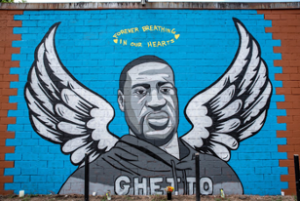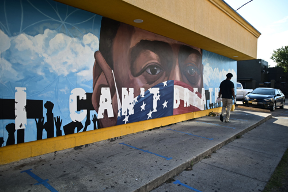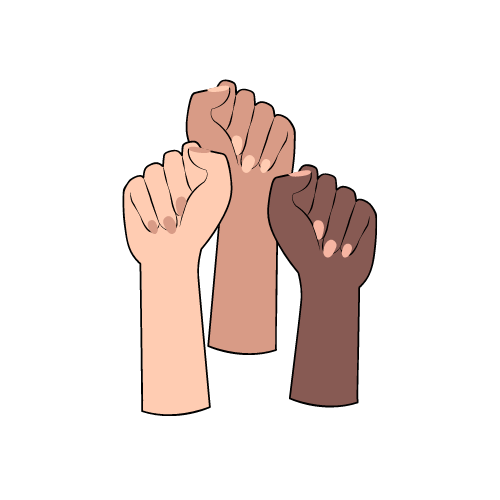Keywords: Street art, social justice, silent activism, Black Lives Matter, awareness, George Floyd, keyboard warriors.
How do we generate awareness about social injustice that lasts and that everyone can relate to or understand?
By including art that mediates social justice into the discussion, in combination with dissemination in the media, it is possible that more people will attend and understand certain movements. Street art is different from street activism and protests that we are used to, that has been discussed in previous blog posts. Street art could be understood as “silent activism” and it is up to us, the audience, to create more discussions and conversations from the messages in the art. People express themselves differently, but they also understand events and movements differently, movements such as Black Lives Matter. Street art is, therefore, an important part of social justice movements as it enables a wide range of people to create understanding in their pace and interpretation. Thus, art is relevant for many reasons when we are talking about social justice and human rights. The relationship between art and human rights can be understood from the shared values of the freedom of expression and creativity (Hajimichael, 2015: 63-64).
I live in Houston, Texas and as I walked through an area that contains most of black-owned businesses, I could see building walls full of powerful and emotional messages and paintings. On one building wall, you see a painting of Barack- and Michelle Obama and now recently a new painting was added next to the former president couple- a painting of George Floyd. Above his head is a text, in the shape of a Gloria, saying, “Forever breathing in our hearts” and on another painting it says, “I can´t breathe”. As I was walking past these huge and powerful paintings, I immediately started and invited to conversations about racism and social injustice. However, to get these conversations and this awareness to last is a challenge.
Houston, Texas George Floyd mural*

(Sergio Flores/Getty Images)

(JOHANNES EISELE/AFP via Getty Images)
Street art creates awareness in societies as it is given to people without them even have to make an effort. People see these paintings while taking a walk, driving past them or from a post in the media. In most cases, something triggers insides of us when we see this type of art. By seeing people’s faces painted on walls and by reading their names, people tend to feel a deeper connection and is likely to spread this awareness further. However, as Mike Hajimichael (2015) says, art is great in terms of democracy and increased participation, but the motivation to participate, to make an actual difference and to be more open keeps resurfacing (Hajimichael, 2015: 1-2). Yet, communities that allow street artists to spread messages about social injustice contribute to a change as these communities enable the conversation to be more visible and physical, to everyone (Lee, 2020, One message told 16 ways: artists behind black lives matter mural in Palo Alto ask what more will be done beyond street art).
The paintings may be temporary but the conversation, awareness and the fight for social justice must continue. Street art is creating awareness, but one should highlight the fact that most paintings come and go. Therefore, we have to show support, spread the art, but we also have to act and take responsibility for what is being said in the art, behind the paintings. In the current society we are all living in, it is more important than ever to not only be a “keyboard warrior” but to actually keep the movement going, apart from solely supporting street art online. However, it will be an ongoing challenge to keep movements relevant and “in the light” continuously, but if we take responsibility for our actions and our support online, then we are on the way to create awareness that may last. It is time not only to look good but to do good.
*The pictures in this post is not taken by the writer (Ellinor Thor).
References
Hajimichael, Mike. 2015. Art and Social Justice: The Media Connection. Cambridge Scholars Publishing.
Lee, Lloyd. 2020. One message told 16 ways: artists behind black lives matter mural in Palo Alto ask what more will be done beyond street art. Wednesday, July 1st, 2020. 5.31 pm. Palo Alto Weekly. Link Available: https://www.paloaltoonline.com/news/2020/07/01/one-message-split-16-ways-artists-behind-black-lives-matter-mural-in-palo-alto-ask-what-more-will-be-done-beyond-street-art
Photos
Hurtado, Alexandra. 2020. 30 Powerful Black Lives Matter Murals from All Over the World You Really Need to See. July 7, 2020. 8.41 am. Parade. Link Available: https://parade.com/1048964/alexandra-hurtado/black-lives-matter-street-art-dc-berlin/

